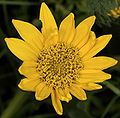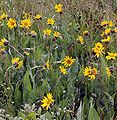Wyethia angustifolia
Wyethia angustifolia, Family: Asteraceae, Mule’s ears, California Compass-plant Narrowleaf Wyethia
Contents
Taxonomy
- Kingdom Plantae – Plants
- Subkingdom -Tracheobionta – Vascular plants
- Superdivision - Spermatophyta – Seed plants
- Division - Magnoliophyta – Flowering plants
- Class
- Subclass
- Order
- Family
- Genus
- Species
Description
General: Tap-rooted, leafy-stemmed perennial, the stems stout but lax, 2-9 dm. tall, the herbage covered with short, stiff, blunt hairs. Leaves: Leaves mostly entire, the basal ones enlarged, with narrow, elongate blades, 1.5-5 dm. long and 2.5-10 cm. wide, tapering at both ends; cauline leaves smaller and variable. Flowers: Heads usually solitary; involucral bracts lance-linear, in several series, herbaceous, with conspicuous hairs on the margins; rays 13-21, chrome-yellow, pistillate and fertile, 1.5-3.5 cm. long; disk flowers light yellow, perfect and fertile; receptacle broadly convex, chaffy throughout, the bracts clasping the achenes; pappus of petal-like appendages. Fruit: Achenes compressed-quadrangular
Bloom Period
- Flowering time: April-July
- Crop intervals: perennial
Distribution
From the east edge of the Columbia Gorge to the confluence of the Willamette river, south through the Willamette Valley of Oregon to California.
Habitat
- The plant prefers light (sandy) and medium (loamy) soils and requires well-drained soil.The plant prefers acid, neutral and basic (alkaline) soils..It cannot grow in the shade.It requires moist soil.
- Meadows and moist, open hillsides at low elevations.
Uses
- Raw stems used for food; seeds used for pinole (food) and dried for winter use; decoction of leaves used to reduces fever and induce perspiration; decoction of roots taken as an emetic; poultice of root lather used for lung problems and to draw blisters
- The seed can be dried, ground into a powder and used as a thickener in soups or can be added to cereal flours when making bread etc. Young leaves can be eaten raw. A lemon-yellow dye is obtained from the flowers. A gold to brass dye is obtained from the flowers, leaves and stems.
Propagation
Soak or stratify seed. Seeds should receive cool-moist stratification 90-120 days for proper germination
Seed
Sample From: 2010
Average Measurement: 7.6 x 2.5 x 2.2
Measurement Range: L: 7 - 8, W: 2 - 3, D: 1.9 - 2.5
Latitudinal Cross Section: circular ![]()
Longitudinal Cross Section: elliptical ![]()
Shape: Seed is long and narrow. Seed is narrow at hilum and broadens at opposite apex.
Additional Structures: Pappus that is attached at apex opposite hilum. Pappus fibers are broad at the base and are attached in a circular pattern. Pappus very brittle, and about ½ the length of the seed body.
Color: Hilum white, seed body medium brown, and pappus is tan to off-white.
Surface: Seed is matte with short bristles that are concentrated toward the pappus. Seed has many longitudinal ridges.
Basic Explanations and Assumptions:
The dimensions for the seeds are length x width x depth. The location of the hilum is used as the base of the seed, and the length is measured from hilum to the opposite apex. Where a style is present, the length is measured from the hilum to the bottom of the style. Width is measured at a right angle to the length at the widest part. Depth is measured at a right angle to the intersection of height and width lines.
Measurements included are the mean average for each measurement of ten separate seeds.
All measurements in millimeters unless otherwise noted.
References
http://plants.usda.gov/java/nameSearch
http://www.wildflower.org/plants/result.php?id_plant=WYAN
http://biology.burke.washington.edu/herbarium/imagecollection.php
http://herb.umd.umich.edu/
http://pfaf.org/user/Plant.aspx?LatinName=Wyethia+angustifolia


